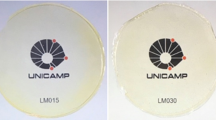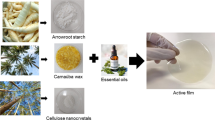Abstract
Lacquer trees (Toxicodendron vernicifluum (Stokes) Barkl.), a significant economic tree species in China, can be availed in the wax/oil industry as its seeds residues contain 43 wt% of amino acids. Films based on Lacquer tree seeds residues protein (LSP) were prepared with casting method and characterized to evaluate the probability of the new protein resource for industry. Besides, chitosan (CH) can help enhance the LSP film performance as an additive. The films' mechanical properties, antibacterial activity and water vapor permeability were measured by tensile strength and elongation at breaking, inhibition zone test, and bottle weighting method, respectively, while Fourier transform infrared spectrum, X-ray diffraction, and scanning electron microscopy were employed to characterize the structure of films. The differences among films were evaluated by the variance analysis via Duncan's multiple range tests. As a result, CH improved the film-forming, water resistance, and mechanical properties of LSP films. CH fused well with LSP to form an agglomerated structure when the mass fraction of CH was over 50%. In addition, the film containing 75 wt% CH and 25 wt% LSP showed higher water resistance and elongation at breaking than 100% CH film. All of the LSP composition films inhibited the growth of S. aureus. However, the composite films showed lower toughness than the carbohydrate film due to the phase separation of the two polymers. LSP-based films showed high application potential for inner packaging due to their outstanding properties.
Graphical abstract







Similar content being viewed by others
Data availability
The datasets generated during the current study are available from the corresponding author on reasonable request.
References
F. Zhang, W. Zhang, S. Wei, Study on Chinese lacquer tree resources and fined utilization. J. Chin. Lacq. 26(2), 36–50 (2007)
J. Norman, Lacquer: technology and conservation: a comprehensive guide to the technology and conservation of Asian and European lacquer. Stud. Conserv. 51(2), 157–158 (2006). https://doi.org/10.1179/sic.2006.51.2.157
Z.Y. Gao, L.N. Sha, Lacquer seed oil and the food culture of the Lisu. J. Ethnol. 6(05), 54–63 (2015)
Y.H. Dong, C.Z. Wang, K. Gong, F.L. Zhang, Research progress on chemical constituents and comprehensive application of lacquer trees. Chem. Indus. For. Prod. 29(S1), 225–232 (2009)
Y. Zhang, H. Jiang, Z. Xiao, The resources and exploitation of the seeds from Rhus verniciflua. Chin. Wild Plant Resour. 36(06), 1–4 (2017). https://doi.org/10.3969/j.issn.1006-9690.2017.06.001
H. Chen, C. Wang, H. Zhou, R. Tao, J. Ye, W. Li, Characterization of polysaccharides purified from Lacquer tree seed cakes and its antioxidant activity. Nat. Prod. Res. 32(18), 2221–2224 (2018). https://doi.org/10.1080/14786419.2017.1366483
B. Hassan, S.A.S. Chatha, A.I. Hussain, K.M. Zia, N. Akhtar, Recent advances on polysaccharides, lipids and protein based edible films and coatings: a review. Int. J. Biol. Macromol. 109, 1095–1107 (2018). https://doi.org/10.1016/j.ijbiomac.2017.11.097
S. Galus, Functional properties of soy protein isolate edible films as affected by rapeseed oil concentration. Food Hydrocoll. 85, 233–241 (2018). https://doi.org/10.1016/j.foodhyd.2018.07.026
A. González, G. Gastelú, G.N. Barrera, P.D. Ribotta, C.I.Á. Igarzabal, Preparation and characterization of soy protein films reinforced with cellulose nanofibers obtained from soybean by-products. Food Hydrocoll. 89, 758–764 (2019). https://doi.org/10.1016/j.foodhyd.2018.11.051
N. Oladzadabbasabadi, A.M. Nafchi, F. Ariffin, M.M.J.O. Wijekoon, A.A. Al-Hassan, M.A. Dheyab, M. Ghasemlou, Recent advances in extraction, modification, and application of chitosan in packaging industry. Carbohyd. Polym. 277, 118876 (2022). https://doi.org/10.1016/j.carbpol.2021.118876
M. Hadidi, S. Jafarzadeh, M. Forough, F. Garavand, S. Alizadeh, A. Salehabadi, A.M. Khaneghah, S.M. Jafari, Plant protein-based food packaging films: recent advances in fabrication, characterization, and applications. Trends Food Sci. Technol. 120, 154–173 (2022). https://doi.org/10.1016/j.tifs.2022.01.013
S. Jafarzadeh, M. Forough, S. Amjadi, V.J. Kouzegaran, H. Almasi, F. Garavand, M. Zargar, Plant protein-based nanocomposite films: a review on the used nanomaterials, characteristics, and food packaging applications. Crit. Rev. Food Sci. Nutr. (2022). https://doi.org/10.1080/10408398.2022.2070721
V. Akhila, L.S. Badwaik, Recent advancement in improvement of properties of polysaccharides and proteins based packaging film with added nanoparticles: a review. Int. J. Biol. Macromol. 203, 515–525 (2022). https://doi.org/10.1016/j.ijbiomac.2022.01.181
Y.H. Dong, C.Z. Wang, J.Z. Ye, J.J. Yuan, Y. Zhou, Y.F. He, Physicochemical properties of lacquer oils. Chem. Indus. For. Prod. 32(04), 28–32 (2012)
A. Gerzhova, M. Mondor, M. Benali, M. Aider, Study of total dry matter and protein extraction from canola meal as affected by the pH, salt addition and use of zeta-potential/turbidimetry analysis to optimize the extraction conditions. Food Chem. 201, 243–252 (2016). https://doi.org/10.1016/j.foodchem.2016.01.074
S.S. Chen, H.J. Tao, Y.J. Wang, Z.S. Ma, Process optimization of soy protein isolate-based edible films containing nanocrystalline cellulose from sunflower seed hull and chitosan. Trans. Chin. Soc. Agric. Eng. 32(8), 302–308 (2016)
W. Zhang, J. Chen, Y. Chen, W. Xia, Y.L. Xiong, H. Wang, Enhanced physicochemical properties of chitosan/whey protein isolate composite film by sodium laurate-modified TiO2 nanoparticles. Carbohyd. Polym. 138, 59–65 (2016). https://doi.org/10.1016/j.carbpol.2015.11.031
C. Zhang, Z. Wang, Y. Li, Y. Yang, X. Ju, R. He, The preparation and physiochemical characterization of rapeseed protein hydrolysate-chitosan composite films. Food Chem. 272, 694–701 (2019). https://doi.org/10.1016/j.foodchem.2018.08.097
B. Prandi, A. Faccini, F. Lambertini, M. Bencivenni, M. Jorba, B.V. Droogenbroek, G. Bruggeman, J. Schöber, J. Petrusan, K. Elst, S. Sforza, Food wastes from agrifood industry as possible sources of proteins: a detailed molecular view on the composition of the nitrogen fraction, amino acid profile and racemisation degree of 39 food waste streams. Food Chem. 286, 567–575 (2019). https://doi.org/10.1016/j.foodchem.2019.01.166
S.W. Kang, M.S. Rahman, A.N. Kim, K.Y. Lee, C.Y. Park, W.L. Kerr, S.G. Choi, Comparative study of the quality characteristics of defatted soy flour treated by supercritical carbon dioxide and organic solvent. J. Food Sci. Technol. 54(8), 2485–2493 (2017). https://doi.org/10.1007/s13197-017-2691-8
X.Z. Song, C.J. Zhou, F. Fu, Z.L. Chen, C.Q. Wu, Effect of high-pressure homogenization on particle size and film properties of soy protein isolate. Ind. Crops Prod. 43, 538–544 (2013). https://doi.org/10.1016/j.indcrop.2012.08.005
Y. Gokce, B. Cengiz, N. Yildiz, A. Calimli, Z. Aktas, Ultrasonication of chitosan nanoparticle suspension: influence on particle size. Coll. Surf. A 462, 75–81 (2014). https://doi.org/10.1016/j.colsurfa.2014.08.028
A.B.T. Constantino, E.E. Garcia-Rojas, Microencapsulation of betanin by complex coacervation of carboxymethylcellulose and amaranth protein isolate for application in edible gelatin films. Food Hydrocoll. (2022). https://doi.org/10.1016/j.foodhyd.2022.107956
H. Li, X. Zhang, S. Tan, G. Tan, H. Zhang, N. Xia, L. Jiang, H. Ren, A.M. Rayan, Intelligent colorimetric soy protein isolate-based films incorporated with curcumin through an organic solvent-free pH-driven method: properties, molecular interactions, and application. Food Hydrocoll. 133, 107904 (2022). https://doi.org/10.1016/j.foodhyd.2022.107904
S.J. Calva-Estrada, M. Jiménez-Fernández, E. Lugo-Cervantes, Protein-based films: advances in the development of biomaterials applicable to food packaging. Food Eng. Rev. 11(2), 78–92 (2019). https://doi.org/10.1007/s12393-019-09189-w
L. Tavares, H.K.S. Souza, M.P. Gonçalves, C.M.R. Rocha, Physicochemical and microstructural properties of composite edible film obtained by complex coacervation between chitosan and whey protein isolate. Food Hydrocoll. 113, 106471 (2021). https://doi.org/10.1016/j.foodhyd.2020.106471
A. Homez-Jara, L.D. Daza, D.M. Aguirre, J.A. Muñoz, J.F. Solanilla, H.A. Váquiro, Characterization of chitosan edible films obtained with various polymer concentrations and drying temperatures. Int. J. Biol. Macromol. 113, 1233–1240 (2018). https://doi.org/10.1016/j.ijbiomac.2018.03.057
V. Mihalca, A.D. Kerezsi, A. Weber, C. Gruber-Traub, J. Schmucker, D.C. Vodnar, F.V. Dulf, S.A. Socaci, A. Farcas, C.I. Muresan, R. Suharoschi, O.L. Pop, Protein-based films and coatings for food industry applications. Polymers 13(5), 769 (2021). https://doi.org/10.3390/polym13050769
S. Kumar, A. Mukherjee, J. Dutta, Chitosan based nanocomposite films and coatings: emerging antimicrobial food packaging alternatives. Trends Food Sci. Technol. 97, 196–209 (2020). https://doi.org/10.1016/j.tifs.2020.01.002
L. Sharma, C. Singh, Sesame protein based edible films: development and characterization. Food Hydrocoll. 61, 139–147 (2016). https://doi.org/10.1016/j.foodhyd.2016.05.007
J.F. Su, Z. Huang, X.Y. Yuan, X.Y. Wang, M. Li, Structure and properties of carboxymethyl cellulose/soy protein isolate blend edible films crosslinked by Maillard reactions. Carbohyd. Polym. 79(1), 145–153 (2009). https://doi.org/10.1016/j.carbpol.2009.07.035
A.R. Dudhani, S.L. Kosaraju, Bioadhesive chitosan nanoparticles: preparation and characterization. Carbohyd. Polym. 81(2), 243–251 (2010). https://doi.org/10.1016/j.carbpol.2010.02.026
S.S. Silva, B.J. Goodfellow, J. Benesch, J. Rocha, J.F. Mano, R.L. Reis, Morphology and miscibility of chitosan/soy protein blended membranes. Carbohyd. Polym. 70(1), 25–31 (2007). https://doi.org/10.1016/j.carbpol.2007.02.023
P. Bergo, P.J.A. Sobral, Effects of plasticizer on physical properties of pigskin gelatin films. Food Hydrocoll. 21(8), 1285–1289 (2006). https://doi.org/10.1016/j.foodhyd.2006.09.014
C.O. Ferreira, C.A. Nunes, I. Delgadillo, J.A. Lopes-da-Silva, Characterization of chitosan–whey protein films at acid pH. Food Res. Int. 42(7), 807–813 (2009). https://doi.org/10.1016/j.foodres.2009.03.005
W. Ma, C.H. Tang, X.Q. Yang, S.W. Yin, Fabrication and characterization of kidney bean (Phaseolus vulgaris L) protein isolate–chitosan composite films at acidic pH. Food Hydrocoll. 31(2), 237–247 (2013). https://doi.org/10.1016/j.foodhyd.2012.10.007
J.M. Fan, W. Ma, G.Q. Liu, S.W. Yin, C.H. Tang, X.Q. Yang, Preparation and characterization of kidney bean protein isolate (KPI)–chitosan (CH) composite films prepared by ultrasonic pretreatment. Food Hydrocoll. 36, 60–69 (2014). https://doi.org/10.1016/j.foodhyd.2013.08.024
D. Kumar, P. Kumar, J. Pandey, Binary grafted chitosan film: synthesis, characterization, antibacterial activity and prospects for food packaging. Int. J. Biol. Macromol. 115, 341–348 (2018). https://doi.org/10.1016/j.ijbiomac.2018.04.084
E.M. Zadeh, S.F. O’Keefe, Y.T. Kim, J.H. Cho, Evaluation of enzymatically modified soy protein isolate film forming solution and film at different manufacturing conditions. J. Food Sci. 83(4), 946–955 (2018). https://doi.org/10.1111/1750-3841.14018
J. Ji, S. Hao, W. Liu, D. Wu, T. Wang, Y. Xu, Preparation, characterization of hydrophilic and hydrophobic drug in combine loaded chitosan/cyclodextrin nanoparticles and in vitro release study. Coll. Surf. B 83(1), 103–107 (2011). https://doi.org/10.1016/j.colsurfb.2010.11.005
Acknowledgements
This research was supported by the National Key Research and Development Program of China (Grant No. 2018YFE0127000 and 2017YFD0600705).
Author information
Authors and Affiliations
Corresponding author
Ethics declarations
Conflict of interest
The authors declare that they have no known competing financial interests or personal relationships that could have appeared to influence the work reported in this paper.
Additional information
Publisher's Note
Springer Nature remains neutral with regard to jurisdictional claims in published maps and institutional affiliations.
Rights and permissions
Springer Nature or its licensor holds exclusive rights to this article under a publishing agreement with the author(s) or other rightsholder(s); author self-archiving of the accepted manuscript version of this article is solely governed by the terms of such publishing agreement and applicable law.
About this article
Cite this article
Wu, Y., Ma, W., Liu, Z. et al. Composite films based on a novel protein and chitosan: characterization and properties. Food Measure 17, 87–97 (2023). https://doi.org/10.1007/s11694-022-01610-z
Received:
Accepted:
Published:
Issue Date:
DOI: https://doi.org/10.1007/s11694-022-01610-z




